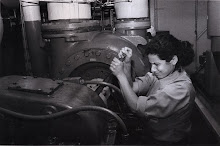
Saturday, October 18, 2008
Street and Studio: an urban history of photography

Wednesday, October 15, 2008
Sunday, September 28, 2008
three images that made me think
First image:
Jeff Whetstone
Post-Pleistocene
September 12 - October 25, 2008

Julie Saul Gallery is pleased to announce our first solo exhibition of photographs by Jeff Whetstone. Whetstone is known for his depictions of rural southern men and the liminal space between culture and wilderness; man and animal. In a new body of work, Post-Pleistocene, Whetstone explores this theme through photographs of the interiors of caves. A native of Tennessee, Whetstone engages the intimacy and community of the world underground.
During the Civil War, caves in Tennessee and Alabama were mined for their saltpetre soil, which was used to produce gunpowder. These caves have since become sites of lore, obsession, and extensive exploration, resulting in an expansive record of human markings, signatures, drawings, and messages. The caves have been so heavily visited that the markings are often several layers deep.
Whetstone sees these cave walls in relation to Pleistocene era drawings, like those in the caves of Lascaux, France. Here he finds the evolution of human expression represented - from frank representations of nature, to layered, expressive gestures reflecting a culture fascinated with personal identity.
I selected this image because it made me think about identity, both that of "Johnny" and the other people who made their mark on the cave walls, and the identity of the photographer. What does this image tell me about Jeff Whetstone?
second image:
New Photography 2008: Josephine Meckseper and Mikhael Subotzky | View the online feature
September 10, 2008–January 5, 2009

Josephine Meckseper
Blow-Up (Tamara, Michelli, Laura). 2006
Chromogenic color print, 78 11/16 x 62 7/8' (199.9 x 159.8 cm). Courtesy Galerie Reinhard Hauff, Stuttgart; Arndt & Partner, Berlin/Zurich; Elizabeth Dee, New York. © 2008 Josephine Meckseper, Artists Rights Society, New York/VG Bild-Kunst, Bonn
Josephine Meckseper’s photographs and mixed‑medium installations cunningly expose the links between politics and the consumer worlds of fashion and advertising.
Why did I select this image? I love this work!
Third image:
Red Lines
Death Vows
Foreclosures
Risk Structures
Architectures of finance from the Great Depression to the Subprime Meltdown
An exhibition by Damon Rich and the Center for Urban Pedagogy (CUP)
Commissioned by the Center for Advanced Visual Studies and hosted by the MIT Museum

Damon Rich
Damon Rich is an urban designer working at the intersection of design, policy, and the public. His exhibitions use video, sculpture, graphics, and photography to investigate the political economy of the built environment. His work has been exhibited internationally at venues including the Storefront for Art and Architecture and SculptureCenter (New York City), the Haus der Kulturen der Welt (Berlin), Galerie für Zeitgenössische Kunst (Liepzig), the Venice Architecture Biennale, and Netherlands Architecture Institute (Rotterdam). In 1997, he founded the Center for Urban Pedagogy (CUP), a nonprofit organization dedicated to helping people understand and change the places they live.
I selected this image because it makes me angry.
Sunday, August 10, 2008
Three recent images: process snapshots

This photo interests me because it is a photo of someone taking a photo of someone deliberately posing in someone else's artwork.

This image interested me as a very rough snapshot that combines elements of self-consciousness with candid spontaneity. It is in a celebrity's house, but no celebrities are pictured.

I am looking at this photo as an example of celebrities who are both self-conscious and not self-conscious of the act of being photographed. It is a very rough snapshot taken in a VIP locations, so it also serves as a trophy for me.
Three images from exhibitions in New York City that attracted my attention

"on view through September 14, 2008"This special exhibition traces Robert Mapplethorpe's use of instant photography from 1970 to 1975. Created in collaboration with the Robert Mapplethorpe Foundation, the show brings together one hundred objects, many never exhibited before. Included are self-portraits, figure studies, still lifes, and portraits of lovers and friends including Patti Smith, Sam Wagstaff, and Marianne Faithfull. Many of these small, intimate photographs convey tenderness and vulnerability. Others depict a toughness and immediacy that would give way in later years to more classical form. Unlike the highly crafted images Mapplethorpe staged in the studio and became famous for, these disarming pictures are marked by spontaneity and invention. Together, they offer insight into the artist's creative development and reveal his pure delight in seeing at a formative time in his career. The show will be accompanied by a book that places this early work in the context of his life-long artistic production."
I selected this image for its snapshot quality and how it differs from Mapplethorpe's more formal work. I can sense the spontaneity that is possible with polaroids.

Louise Bourgeois being photographed by Andy Warhol in 1987 in front of her painting 1932 (1947) Photo by Baird Jones.
It is from the exhibition A Life in Pictures: Louise Bourgeois currently at the Guggenheim Museum in New York City.
I selected this photograph because it depicts one celebrity photographing another celebrity, and makes me conscious of the act of photographing itself. I also enjoy photographing other photographers photographing.

Tomoko Sawada
From the series "School Days," 2004
© Tomoko Sawada
Courtesy of MEM Inc. and Zabriskie Gallery
This photograph is currently part of the exhibition Heavy Light: Recent Photography and Video from Japan at the ICP International Center for Photography. I selected it because I saw in it an odd disparity between the feeling of a uniform group of people and the individuality I can see in each student's facial expression & hairstyle. Also I read a similar disparity in the juxtaposition of the traditional cherry blossoms and the high modernist structure in front of which the class is posing.






